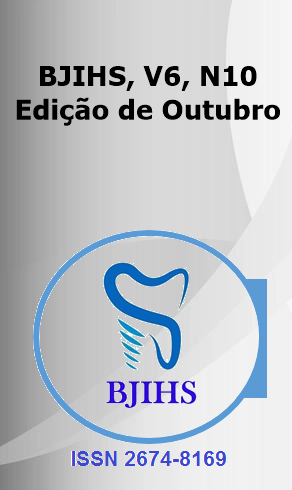Abstract
INTRODUCTION: Cardiac magnetic resonance imaging (CMRI) is a noninvasive imaging technique that allows a detailed assessment of the structure and function of the heart, being useful in identifying conditions such as myocarditis and cardiomyopathies. The application of Artificial Intelligence (AI) in the analysis of these images promises to increase diagnostic accuracy and efficiency in clinical management, as machine learning algorithms can identify subtle patterns that may go unnoticed by human observers. OBJECTIVE: The main objective of this review is to evaluate the effectiveness of Artificial Intelligence (AI) in the analysis of Cardiac Magnetic Resonance (CMRI) images. METHODOLOGY: This systematic review article, structured according to the PRISMA guidelines, aims to identify, evaluate and synthesize evidence on the use of Artificial Intelligence (AI) in the analysis of Cardiac Magnetic Resonance (CMRI) images to detect inflammation and scarring in the heart muscle. The review covered several steps, including the definition of the research question, study selection, data extraction and critical analysis of the results. Data analysis focused on identifying recurring patterns and themes, and the methodological quality of the studies was assessed using tools such as AMSTAR and the Newcastle-Ottawa Scale. RESULTS: The systematic review showed that AI algorithms, especially convolutional neural networks (CNNs), significantly improve diagnostic accuracy compared to conventional analysis. AI can achieve sensitivity and specificity rates greater than 90% in detecting myocardial inflammation and scarring. The implementation of AI in CMR analysis has the potential to transform the clinical management of patients with cardiac diseases, allowing for faster and more targeted interventions. CONCLUSION: The systematic review showed that the application of Artificial Intelligence (AI) in the analysis of cardiac magnetic resonance (CMR) images significantly improves the detection of myocardial inflammation and scarring. Machine learning algorithms, especially convolutional neural networks, demonstrated greater efficacy compared to conventional analysis by radiologists, allowing for faster and more effective interventions.
References
NATIONAL CENTER FOR BIOTECHNOLOGY INFORMATION. A miocardite aguda pode mimetizar IAM com dor. PubMed Central, 2024. Disponível em: https://www.ncbi.nlm.nih.gov/pmc/articles/PMC9352123/#:~:text=A miocardite aguda pode mimetizar IAM com dor. Acesso em: 03 out. 2024.
PRAÇA et al. Inibidores de SGLT2 no tratamento da Insuficiência Cardíaca. Revista Brasileira de Revisão em Saúde, 2023. doi:10.34119/bjhrv6n3-102.
LIMA, Papel da inteligência artificial na predição de eventos cardíacos. Revista Brasileira de Implantologia e Ciências da Saúde, 2024. doi:10.36557/2674-8169.2024v6n2p2213-2229.
HEIMBECK, Novas terapias para cardiomiopatia hipertrófica: uma revisão integrativa. Revista Brasileira de Pesquisa em Saúde/Brazilian Journal of Health Research, 2024. doi:10.47456/rbps.v26isupl_1.44403.
BRAGA, A. Doença cardíaca isquêmica: aspectos epidemiológicos, fisiopatológicos e manejo terapêutico. Brazilian Journal of Health Review, v. 6, n. 3, p. 13172-13188, 2023. doi:10.34119/bjhrv6n3-372.
MARTINS, Avanços em inteligência artificial em cardiologia: uma revisão abrangente. Revista Ibero-Americana de Humanidades Ciências e Educação, 2024. doi:10.51891/rease.v10i4.13643.
NEVES, Usos da inteligência artificial na cardiologia: uma revisão da literatura. Brazilian Journal of Health Review, 2023. doi:10.34119/bjhrv6n6-267.
CHIAVENATO et al. Ressonância Magnética Cardíaca como Ferramenta Diagnóstica Etiológica em Pacientes Recuperados de Morte Súbita Cardíaca ou Arritmias Ventriculares Instáveis. Arquivos Brasileiros de Cardiologia, 2023. doi:10.36660/abc.20220411.
MONTEIRO, Miocardite associada ao COVID-19: abordagens patogênicas e diagnósticas emergentes. Revista Brasileira de Implantologia e Ciências da Saúde, 2024. doi:10.36557/2674-8169.2024v6n6p613-624.
SOARES et al. O uso da inteligência artificial na medicina: aplicações e benefícios. Research Society and Development, 2023. doi:10.33448/rsd-v12i4.40856.
LINO, Paraganglioma do corpo carotídeo: um relato de caso. Brazilian Journal of Health Review, 2023. doi:10.34119/bjhrv6n6-361.

This work is licensed under a Creative Commons Attribution 4.0 International License.
Copyright (c) 2024 Eder Voltolini, Carolina Dossena, Rhuan Nantes Fontoura Teofilo, Eliézer Ferreira da Silva , Maycon Jorge Brandolim , Gabriel Henrique do Prado Gonçalves, Carlos Gabriel Monteiro Pereira, Leonardo Sanches Furlan , Ana Beatriz Barbosa Lopes, Euller Condé Fernandes , Ingridy Rhaiany Parreira Menegassi , Fernando Malachias de Andrade Bergamo , Isadora Macedo Nunes , Joselita Bezerra Cavalcante, Cleidi Boing Voltolini
